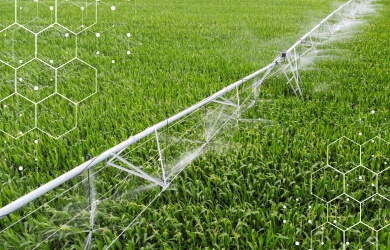AI in Agriculture – Smart Water Management Using Agritech

Artificial intelligence (AI), machine learning (ML), and the Internet of Things (IoT) sensors have recently been disrupting industries with their wide range of capabilities including augmenting human intelligence and processing huge chunks of data. As AI, in particular, makes headway into agriculture to enhance productivity and resource management, there have been several discussions on how the new technology can help solve water efficiency problems in this sector.
Amidst climate change and subsequent rise in disaster events, ranging from flood and tropical storms to droughts and reduced groundwater reserves, the agriculture industry faces as well as contributes to water risks. As per the World Bank, agriculture accounts for about 72% of all water withdrawals across the globe. Simultaneously, large volumes of the water pumped or diverted for irrigation is wasted due to the inefficiency of irrigation performance indicators. Furthermore, this water often seeps back to the ground, leading to waterlogging and salinity.
Along with these issues, farmers are facing challenges regarding the need to increase food production to feed the increasing world population. Improving water management in agriculture is, therefore, crucial to ensuring a sustainable and productive food sector. In this article, you will learn about how AI in agriculture can be of great benefit to boosting the water management efforts of agribusinesses.
The Rise of AI and Its Application in Agriculture Water Management
As big data analytics and smart sensors gained momentum, agriculture has become one of the fertile industries for precision farming methods and visibility tools. Subsequently, disruptive technologies such as AI have brought an agriculture revolution. AI has protected crops from various factors including climate changes, population growth, and food security problems, and it is making greater strides in improving water efficiency in agriculture.
AI in Different Types of Irrigation Systems
AI in agriculture is becoming the bedrock of automation. It helps automate simple and mundane tasks such as gathering field information, labelling and analysing data, developing reports, and sending notifications. The impact of these small steps on agriculture practices can be seen in a short period of time.
Smart irrigation involves minimized water use, reduced human efforts, a unified view of soil characteristics, and enhanced long-term landscape health along with cost savings. Today, different types of water irrigation systems extensively use IoT sensors and AI systems to achieve these advantages.
Sprinkler Irrigation: An AI-based irrigation system collects data from thermal and acoustic rain sensors that measure the intensity of rainfall to schedule the next irrigation. Upon analysis and calculation of this data, the system sends automated notifications to sprinklers to prevent overwatering or extensive use of water.
Center Pivot Irrigation: In-field sensors provide data insights to the AI-based system that controls circle irrigation sprinklers and adjusts the stream or angle of water flow. Rather than overwatering the nearest plants, this helps reach plants that are far from the water source.
Drip and Micro Irrigation: In these types of irrigation, water is applied directly to the plant’s roots that ensure uniform distribution, reduce evaporation and runoff, and improve irrigation efficiency. AI algorithms can be applied to precisely control the amount of water to be applied for a specific crop.
AI Analytics for Data-driven Water Management Decisions
The quality of crops depends on the appropriate amount of watering since overwatering and under watering may damage crops or hinder their growth. Additionally, the soil must be moist and the required humidity must be maintained. However, it is still difficult for farmers to determine the right amount of water to get the preferred yield and quality. Moreover, it is a time-consuming, operationally heavy, and complex process requiring high-quality, localised data inputs.
The ability of AI is much more beyond improving crop yield and reducing production costs. With AI-based agriculture systems that use a range of data sets such as satellite imagery, temperature, humidity, climate, and weather predictions can help build a new automation control for an irrigation system. This will aid farmers in making optimal water management decisions so as to waste less water while conserving energy.
Evapotranspiration, a water cycle that covers both evaporation and transpiration, has long been a key parameter for creating a crop-specific irrigation system. Today, modern satellite imagery, weather predictions, and remote sensing help farmers estimate and improve the assessment of daily rainfall and potential evapotranspiration without the need for site-specific calibration. Weather sensors combined with data provided by a GIS-based system can further help generate more accurate water predictions.
Sensor-based AI Solutions to Optimise Irrigation Scheduling
With the rising need to manage water efficiency problems in agriculture, farmers are making efforts to create a better irrigation schedule for their crops that will not only optimise yield and quality but also keep water usage in check.
Depending on the type of data to be captured – soil, light, weather, and plant, IoT sensors can be used in AI-based irrigation systems capable of delivering strategic insights into the most appropriate times to water crops, use fertilizers or pesticides, etc. Located at important points across the field, soil-based sensors collect relevant data of volumetric water content, salinity, and other crucial parameters that help gain quick insights into soil’s needs and predict irrigation needs in real-time.
Although the application of plant-based sensors mounted to a plant’s stalk or fruits is still in its nascent stage, it is showing great promise in gauging the water status of the plant. These sensors can sense or track small changes such as shrinking or swelling and send alerts about insufficient water content or yield-reducing tendencies in the field. This way, AI in agriculture can prove to be quite useful in understanding water levels in the field and appropriately optimising irrigation scheduling activities for maximum positive results.
AI to Detect Irrigation Malfunctions or Leaks
The fight to manage and preserve water in the agriculture industry goes beyond optimized irrigation systems and the prevention of overwatering. One area that remains a key concern for farmers is the ability to detect malfunctions such as leaks in the irrigation system without the help of personal inspection.
As the power of AI in agriculture grows strong, interconnected devices are increasingly used in the irrigation system, allowing the software to send an alert when something is wrong suspicious. Irrigation sensors can thus discover any irregularity in real-time and connect it to the root issue, enabling farmers to take immediate action.
It is evident that the increasing need to tackle specific water-related issues, especially water scarcity and wastage in agriculture, and make greater sustainability efforts are driving the adoption of AI in agriculture, more significantly in water-based contexts. If this trend continues, machines and autonomous systems will have the ‘intelligence’ to transform the way water is consumed in agriculture.
FarmERP, equipped with advanced AI-based solutions, can help optimise irrigation scheduling, management, and overall water management practices for agribusinesses and enterprises. Contact us today to know more.
